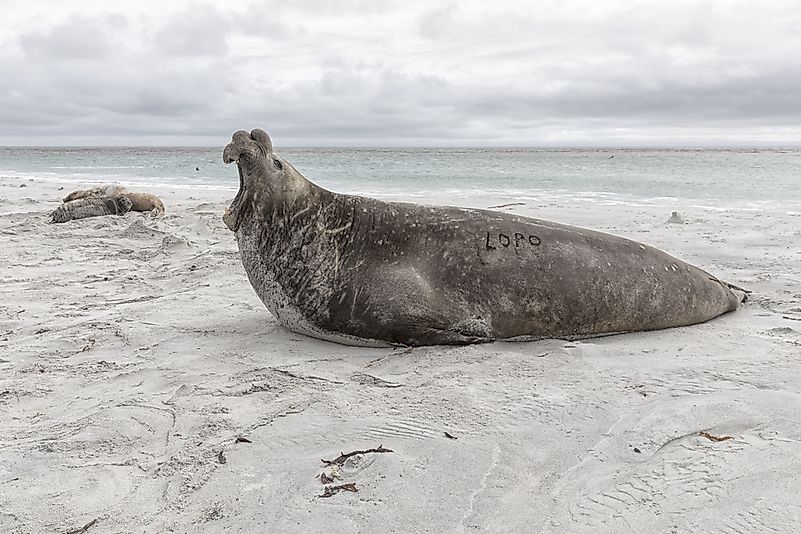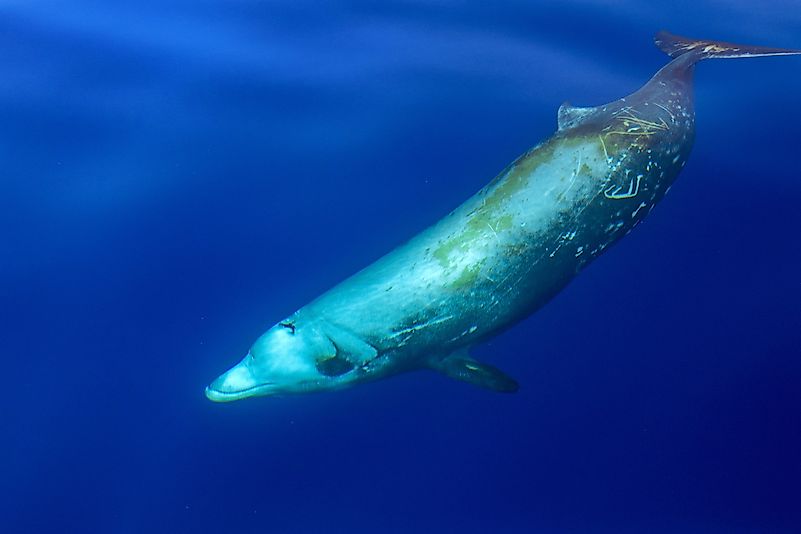Although the sperm whale was long thought to be the world’s deepest diving mammal, the title actually goes to the Cuvier’s beaked whale.
Marine mammals have adapted to rely on the aquatic environment for their survival. They include a wide range of animals from the whale to the manatees and live in both salt water and fresh water. Some marine mammals have evolved to survive entirely in the water such as the whale, while others such as seals spend time both on land and in water. Among the marine mammals, it had long been believed that the sperm whale could dive the deepest to an astonishing 7,382 feet, but a new study by the Scripps Institution of Oceanography has found that the Cuvier’s beaked whale can dive much deeper.
5. Blainville’s Beaked Whale
Blainville’s beaked whales are the widest ranging mesoplodont whale and probably the most well documented. Males reach at least 14 feet and weigh 1,800 pounds with the females being a bit bigger at 15 feet and 2,200 pounds. They usually dive for long periods of time and the deepest documented dive was 5,246 feet. They dive primarily to forage for food and prefer deeper water to avoid predators that hunt in mid-depth waters like killer whales and sharks.
4. Baird’s Beaked Whale
The Baird’s beaked whale is the largest member of the giant beaked whale family and is similar to the Arnoux’s beaked whale. They have a narrow body shape and can grow up to 36 feet. They feed on deep-sea fish, squid, and octopi. They have been observed to dive for an hour at a time to feed with their deepest dive recorded at 5,830 feet. They prefer deep waters near the continental shelf or around seamounts especially when they are feeding. When not diving they drift along the surface.
3. Southern Elephant Seal

The Southern elephant seal is the largest marine mammal that is not a cetacean. The adult male has a large proboscis that it uses to produce thunderous roars especially during the breeding season, hence the name elephant. Their primary feeding area is at the edge of the Antarctic continent where they feed on squid and fish. Their deepest dive has been recorded at 6,998 feet, and they are the deepest diving air-breathing non-cetaceans. They have increased oxygen storage and a reduced rate of consumption making excellent divers.
2. Sperm Whale
The sperm whale is the largest toothed whale and adult males measure around 52 feet and weigh 45 tons, and the females measure 36 feet and weigh 15 tons. They are found in most of the world’s oceans and migrate seasonally for breeding and feeding. They are the second deepest diving mammals plunging to 7,382 feet in search of food. They have a flexible ribcage allowing lung collapse which allows them to cope with drastic pressure change when diving.
1. Cuvier’s Beaked Whale

The Cuvier’s beaked whale is an elusive species of whale that grows to about 16-23 feet and weighs about 5,500 pounds. They feed on deep sea squid and fish and during the hunt for prey they can hold their breaths for more than an hour and a half. Their habitat is varied, and they can thrive in most of the oceans. Scientists at the Scripps Institution of Oceanography monitored the whales diving to depths beyond 9,000 feet in search of food. The deepest dive recorded was 9,816 feet.
Deepest Diving Marine Mammals
| Rank | Mammal | Scientific Name | Dive Depth (ft) |
|---|---|---|---|
| 1 | Cuvier’s beaked whale | Ziphius cavirostris | 9,816 |
| 2 | Sperm whale | Physeter macrocephalus | 7,382 |
| 3 | Southern elephant seal | Mirounga leonina | 6,998 |
| 4 | Baird’s beaked whale | Berardius bairdii | 5,830 |
| 5 | Blainville’s beaked whale | Mesoplodon densirostris | 5,246 |
source https://fourteen.online/top-5-deepest-diving-marine-mammals/
from Dr. Linex https://ift.tt/2TBr1NT
via IFTTT
No comments:
Post a Comment